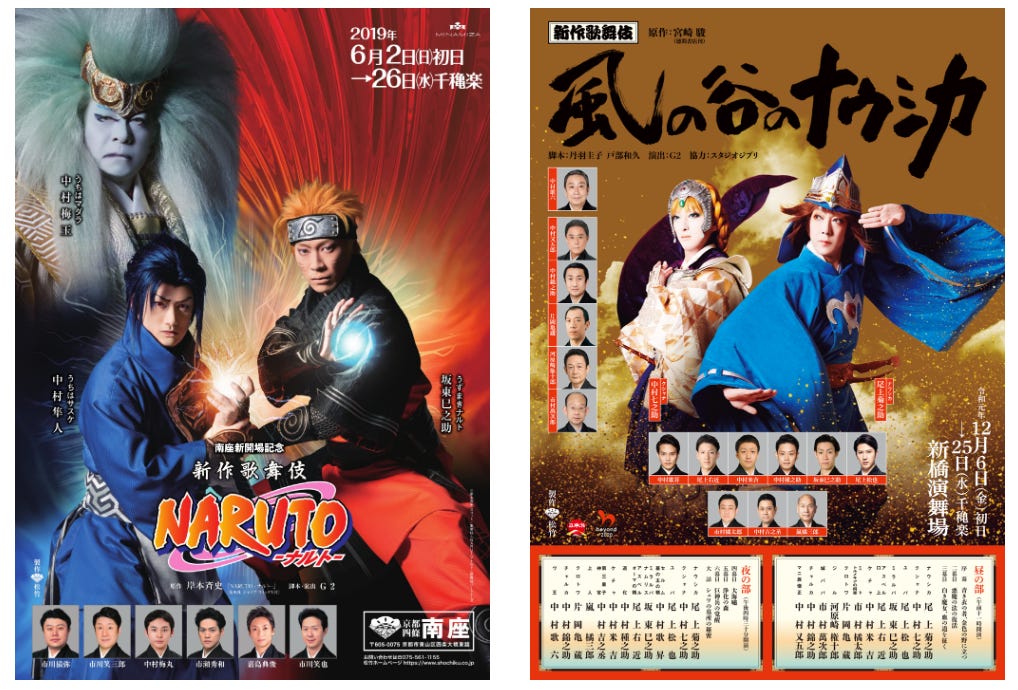Scandals and Spectacles: The Dramatic World of Kabuki
Exploring the controversies and artistry behind a 400-year-old theatrical tradition
Kabuki is considered one of Japan’s great performing arts, representing an all-male theatre that combines singing, dance, performance, and storytelling into a vibrant art form. Although kabuki is now predominantly male, it was originally an all-women affair. To understand this shift, we need to look back to the origins of kabuki four hundred years ago. In the early 1600s, Japan was enjoying newfound peace after decades of warfare. People began to crave for entertainment that would color the monotony of their daily lives.
Around that time, a mysterious woman named Okuni started performing eccentric dances on the bank of the Kamogawa River in Kyoto, marking the beginnings of kabuki. Soon, troupes of women across Japan adopted the name “kabuki” to attract audiences. However, by 1629, the shogunate, worried about the performances’ connections to brothels, banned women from the stage entirely. With women prohibited, beautiful young boys with distinctive pre-adult hairstyles took their place, giving rise to Wakashu Kabuki. These performances included acrobatics and comedic elements while still retaining erotic undertones. The shogunate, dismayed by this, eventually banned Wakashu Kabuki and cracked down on male homosexuality. Thus, the onnagata emerged, a unique feature of kabuki where men perform as women on stage.
During the Edo period, kabuki became the most popular form of entertainment, maintaining its allure over the years, briefly receding during World War II, only to gain popularity again afterward. Today, kabuki continues to attract fans with performances that range from traditional settings to everyday life during the Edo period, as well as modern adaptations of popular anime like "Naruto." One of its most celebrated playwrights, Chikamatsu Monzaemon, often referred to as the “Shakespeare of Japan,” created timeless works such as "The Love Suicides at Sonezaki". This play is based on the tragic double suicide of a couple from Osaka who were unhappy because societal norms prevented them from being together. After the play premiered, there was a rise in double suicides, which led the shogunate to ban it for a period.
In modern times, while kabuki appears steeped in tradition and rules, it is often marred by scandals. Allegations of adultery, assault, secret children with mistresses, and other personal controversies frequently arise among its actors. These performers sometimes seem to follow a moral code that diverges from societal norms.
One of the latest controversies involves Teruyuki Kagawa, known in kabuki as Ichikawa Chūso. Kagawa, a notable film and television actor known for acclaimed works like "Tokyo Sonata" and the popular drama "Hanzawa Naoki", was accused of sexually assaulting a hostess at a bar in Tokyo. These allegations have led to his removal from most sponsorships and television assignments, yet he continues to perform on the kabuki stage.
Another high-profile case involves Kagawa’s cousin, Ennosuke Ichikawa IV, a kabuki and film actor who was recently imprisoned in connection with his parents' tragic deaths, with allegations suggesting his involvement.
Weekly magazines often seek sensational stories about kabuki actors, and such controversies can become media spectacles. Family members of the kabuki actors involved often come under scrutiny, as seen in the case of Kagawa’s 18-year-old son, Masaaki Kagawa, who is also a kabuki actor.
Kabuki troupes are typically centered around traditional families. The eldest son of a kabuki actor inherits the art, undergoing rigorous training from childhood to adulthood to take on the family name. Knowledge and techniques are passed down within families, allowing the art form to remain consistent while adapting to modern audiences. Despite the controversies and secrets within famous kabuki families, the dazzling spectacle of kabuki endures.
With a grand stage, beautiful backdrops, rich costumes, makeup, and live traditional music performed both on stage and backstage, attending a kabuki play is a truly sensory experience. Heroes can transform into villains, and priests can become demons within moments, aided by invisible stagehands clad in black who facilitate these seamless changes.
Kabuki remains a unique and compelling representation of Japanese culture. While some of the actors may get up to unseemly antics in their private lives, their dedication to the craft and ability to mesmerize audiences works in favor of ensuring kabuki continues to be an enduring art form. The drama, visual delight, beautiful costumes often costing several thousands of yen, sophisticated set design, entertaining stage antics, and the sheer energy of a live performance all contribute to kabuki's lasting allure. It's easy to imagine the shock and thrill experienced by those in the Edo period when they first experienced a kabuki performance four hundred years ago.
Note: Simplified commentary in English is available as an audio guide for kabuki performances. While I haven’t personally tried it, having a general understanding of the story and the actors beforehand, possibly paired with the audio guide, could enhance your enjoyment of the show. This site has a lot of easy to understand summaries of various plays.
Selected Sources
https://www.nytimes.com/2018/11/29/theater/japanese-theater-japonismes-2018-paris
Heine, S. (1994). Tragedy and Salvation in the Floating World: Chikamatsu’s Double Suicide Drama as Millenarian Discourse. The Journal of Asian Studies, doi:10.2307/2059839
https://www.yomiuri.co.jp/editorial/20220515-OYT1T50201/
https://www2.ntj.jac.go.jp/unesco/kabuki/jp/history/history1.html
知識ゼロからの歌舞伎入門 Tankobon Hardcover – July 21, 2022 by 松本幸四郎 (読み手)







